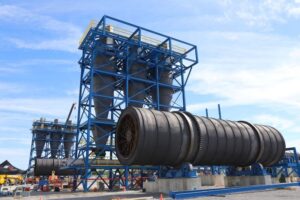IAC to engineer biomass drying solutions for SDI Biocarbon Solutions

Steel Dynamics, Inc. announced the selection of Columbus, Mississippi in the US as the location for the initial SDI Biocarbon Solutions biocarbon production operations, a joint venture between the company and Aymium.
The site is strategically located near one of the company’s largest electric-arc-furnace steel mills, which will consume a portion of the biocarbon as a replacement for anthracite coal and is also central to plentiful sustainably sourced fibre raw material sources.
IAC’s scope of equipment supply includes two Rotary Drum Dryer systems to dry southern yellow pine feedstock as feed for the pyrolysis processors.
IAC’s rotary dryers will primarily use the combustion products from the biogas production as well as recirculated dryer exhaust gases as the drying medium.
A bank of three cyclone collectors separate the dry product from the gas stream. Safety systems include explosion venting, spark detection and suppression, fire water deluge, and oxygen analysers in addition to the fully modulating EGR system minimising the oxygen content within the dryer systems.
PLC-based automated burner management and dryer control systems will integrate with the spark detection/suppression and fire water deluge PLC and plant’s DCS system.
IAC will be providing structural, mechanical, electrical, and automation engineering for the project, as well as project management, construction and commissioning services.
IAC’s construction arm, Adelphi Construction LC, will provide structural and mechanical equipment erection, insulation, piping, automation and electrical installation services. IAC is incorporating Steel Dynamics provided steel into its systems.
“IAC has long been trusted by Steel Dynamics as a provider for dust collection and air pollution control (APC) equipment and engineering services at their mills,” said Mike Sedler, IAC Sr. VP.
“SDI Biocarbon Solution’s project allows us to pair our thermal processing technologies with our dust and APC expertise to assist them in utilising the facility’s excess available renewable energy, representing a meaningful step toward achievement of their environmental goals.”


























